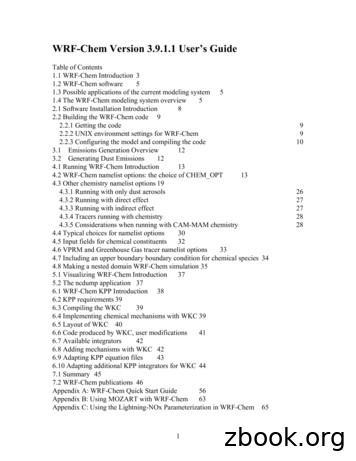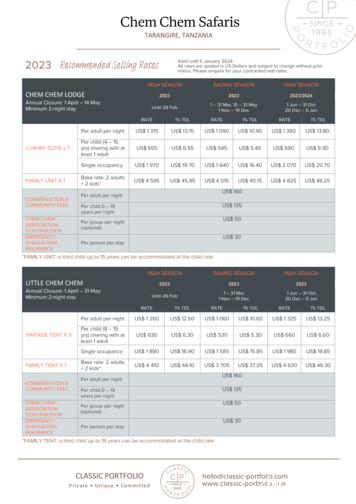Welcome To Jeff’s CHEM 4 Lecture! We’ll Be Starting In .
Welcome to Jeff’s CHEM 4 lecture!We’ll be starting in just a bit While you are waiting:1) Go to LearningCatalytics.comSession ID 141100452) Make sure your Zoom User ID is your “first name last name”. You can open“participants”, then find your name and click on it to change it.3) In the chat, let us know What is a CHEM 4 study tip that you’d recommend toyour classmates?1
Exam #1 results Class average 78% Historical ave 74%, but it wasn’t open book. Still given everything we are dealing with, I’m genuinely proud of you all!What to improve? Here’s our checklist of key behaviors that lead to success in CHEM 4: Visit our CHEM 4 website regularly: tinyurl.com/SacStateChem4 Attend every lecture having completed the assigned reading. Review our PowerPoint slides and/or lecture recordings after each class. Keep up with daily homework. However, all students will automatically receive fullcredit for all late homework this semester. Complete all of the practice exams. Start formal studying for exams 1 week early. Get help when needed: Put together a weekly study group. Jeff’s office hours: MWF 9 – 9:30 am and 11 – 11:30 am; and by appointment. PAL office hours: link is on our CHEM 4 website. Everyone deserves a second chance! C2S program allows you to drop lowest exam.2
Survey questionGo to LearningCatalytics.comSession ID 14110045Thank you for being flexible with regards to rescheduling Exam #1! How does that impact our semester? I skipped “climate change”1) In week #9, which two things should we do in addition to Exam #2 on Friday?A) Heat capacity (3.12 cont.) and review sessionB) Heat capacity (3.12 cont.) and climate changeC) Climate change and review session3
CHEM 4 lectureMonday – October 5, 2020Sec 2.1 – 2.4Significant figures and measurements
Reading clicker question (Covers material from today’s assigned reading)Go to LearningCatalytics.comSession ID 141100452) Which of the following statements is false?A) Scientific notation is used to convert very large and very small numbers tomore compact numbers.B) Significant figures represent the precision of a measured quantity.C) A value with fewer significant figures is less precise than a value with moresignificant figures.D) Zeros are always treated as significant figures.E) An exact number has an unlimited number of significant figures.5
Background: Exact numbersExact numbers are not measurements. They do not have any uncertainty associatewith them and therefore they have infinite significant figures.There are 3 types of exact numbers:1) Definitions: 1 m 100 cm 1 dozen eggs 12 eggs 12.00000000000000000000000 eggs2) Whole number things that you can exactly count: # of CHEM 4 students in our Zoom session right now # of letters on this slide3) Integers that are part of mathematical equations: Volume of a sphere 4/3 πr36
Background: Measurements In contrast to exact numbers, measurements are when weassign a number to a characteristic of an object or event. A measurement is made by comparing a quantity with astandard unit. Since this comparison cannot be perfect, measurementsinherently include error, which is how much a measured valuedeviates from the true value. There is no such thing as an “exact measurement”Allowed to have one guess digit after all of the certain digitsCertain digits the guess digits significant figuresAbbreviated: sig fig or s.f. Useful guideline: make the measurement to 1/10th of thesmallest division.7
Background: MeasurementsThis mass has 4significant figures.The guess digit isalready included.8
Background: MeasurementsUseful guideline: Make the measurementto 1/10th of the smallest division. We are sure about the 1.2 cm Then we get a guess digit. It should be reasonable (not 1.21), butit might not be the same as your labpartner. For example, 1.27 cm or 1.28 cm wouldboth be acceptable measurements.1.21.39
Progress clicker question (covers material we are learning now)Go to LearningCatalytics.comSession ID 141100453) Your thermometer has markings every 1 C. Your sample temperature readsbetween the 20 C and 30 C markings as seen in the photo below. Whichreading is reasonable to record in your lab note book?A) about 20 CB) about 30 CC) 25 CD) 27 CE) 27.1 CF) 27.6 CG) 27.05 C27 C28 C10
Background: Rules for determining significant figuresWhen dealing with someone else’s measurement, how do we know if a digit is asignificant figure?1) The following are always significant: non-zeros (ex. 684.23 5 sf) zeros between non-zeros (ex. 5.00301 6 sf) zeros at the end of a number, if there is a decimal point (ex. 430.0 4 sf)2) The following are never significant: zeros at start of a number (ex. 0.0009 1 sf)3) Ambiguous zeros: zeros at the end of a number, if there is no decimal point (ex. 6000 1 sf)11
Background: Ambiguous zerosNotes about ambiguous zeros: If we are given a number with ambiguous zeros, we assume the worst and don’tcount them. We never write the results of our calculations with ambiguous zeros. Instead, wecan use scientific notation to clarify ambiguous zeros.Example: If we calculate an answer of 6000 g, it can be written with scientificnotation to clarify how many, if any, of the zeros are significant. If we want 4 sf, we write it as 6.000 x 103 g. If we want 3 sf, we write it as 6.00 x 103 g. If we want 2 sf, we write it as 6.0 x 103 g. If we want only 1 sf, the same number would be written as 6 x 103 g.12
Practice: Counting sig figs in measured valuesMeasurement# of sig figs2,300.28010 cm0.00006800 mL4,500 min704,009 m53,080,000 ft330.000 kg13
Progress clicker question (covers material we are learning now)Go to LearningCatalytics.comSession ID 141100454) Which of the following measurements has the greatest number of significantfigures?(3 sf)A) 6.0500 (5 sf)D) 605000B) 0.605E) 0.0000605 (3 sf)(3 sf)C) 0.06050 (4 sf)F) 605.0(4 sf)14
Background: Determining sig figs in calculations (x/ )When multiplying and dividing measurements: Answer can’t have more sig figs that the measurement with the fewest sig figs.Steps:1) Write down the entire number from your calculator.2) Determine sig figs for each measurement used in the calculation.3) Round answer so it has the same # of sig figs as measurement with fewest sig figs. Round if leftmost digit dropped is 4. Round if leftmost digit dropped is 5.4) Make sure final answer has correct units.Example: If it takes you 12.356 hours to drive 650 miles, what is you velocity in mi/hourreported with the correct number of sig figs?Step 2)2sf5sf650 miles12.356 hoursStep 1)Step 4) 52.60602137 53 mi/hr (or 53 mph)Round answer to 2 sf.Leftmost dropped digitStep 3) is “6” so round up.15
Progress clicker question (covers material we are learning now)Go to LearningCatalytics.comSession ID 141100455) Perform the following calculation and report the answer with the correctnumber of significant figures:(0.0030 cm) x (9.55 cm) x (6.13 cm)A) 0.175625 cm3B) 0.17562 cm3C) 0.1756 cm3D) 0.176 cm3E) 0.18 cm3F) 0.2 cm3Answer:(0.0030 cm) x (9.55 cm) x (6.13 cm) 0.1756245 cm3 0.18 cm32sf3sf3sfkeep 2sfround up16
Progress clicker question (covers material we are learning now)Go to LearningCatalytics.comSession ID 141100456) Perform the following calculation and report the answer with the correctnumber of significant figures:4.91 m 500 sA) 0.00982 m/sB) 0.001 m/sC) 0.01 m/sD) 0.0098 m/sE) 0.009 m/sAnswer:4.91 m 500 s 0.00982 m/s 0.01 m/s3sf1sfkeep 1sfround upThe answer is not 0.001 m/s.Make sure the 9 rounds up to 10.so 0.009 becomes 0.010, thenkeep 1 sig fig to give 0.01 m/s.17
A) Scientific notation is used to convert very large and very small numbers to more compact numbers. B) Significant figures represent the precision of a measured quantity. C) A value with fewer significant figures is less precise than a value with more significant figures. D) Zeros are always treated as significant figures.
Jeff Branch WOODWORKING Publisher: Jeff Branch Editor: Jeff Branch Art Direction: Jeff Branch Contributing Editor: Jeff Branch Illustration: Jeff Branch Marketing: Jeff Branch Basically, I created this document all by myself. ***** On the cover: The design for this cupboard started as a traditional, sort of primitive form,
Jeff Davis County - Jeff Davis Pre-K, Jeff Davis Learning Center, Mt. Zion Learning Center, Head Start, Jeff Davis Primary, Jeff Davis Elementary, Jeff Davis Middle, Jeff Davis High 3 Literacy Assessments. The JDCSS student assessment system is arranged in three tiers consisting of state-mandated, district-level, and building-level assessments.
CHEM 350B Topics in Chemistry 7.5 454.95 CHEM 351 Chemicals Big and Small: Nano- 15 909.90 CHEM 352 Advanced Concepts in Chemistry 15 909.90 CHEM 352A Advanced Concepts in Chemistry 7.5 454.95 CHEM 352B Advanced Concepts in Chemistry 7.5 454.95 CHEM 360 Contemporary Green Chemistry 15 909.90 CHEM 380 Materials Chemistry 15 909.90
CHEM 31X. Chemical Principles 4 CHEM 33. Structure and Reactivity 4 CHEM 35. Organic Monofunctional Compounds 4 CHEM 36. Organic Chemistry Laboratory I 3 MATH 41, 42, 51. Calculus, Linear Equations 5 5 5 SECOND YEAR CHEM 130. Organic Chemistry Laboratory II 4 CHEM 131. Organic Polyfunctional Compounds y3 CHEM 134.
CHEM 110 Chemistry of the Living World 15 4,736.85 CHEM 120 Chemistry of Material World 15 4,736.85 CHEM 150 Concepts in Chemistry 15 4,736.85 CHEM 200 Special Topic 15 4,736.85 CHEM 251 Structure and Spectroscopy 15 4,736.85 CHEM 252 Properties and Analysis of Mat 15 4,736.85
WRF-Chem Version 3.9.1.1 User’s Guide Table of Contents 1.1 WRF-Chem Introduction3 1.2 WRF-Chem software 5 1.3 Possible applications of the current modeling system 5 1.4 The WRF-Chem modeling system overview 5 2.1 Software Installation Introduction 8 2.2 Building the WRF-Chem code 9 2.2.1 Getting the code 9
bonding and reactions) necessary for courses in elementary organic chemistry and physiological chemistry. Students may only receive credit toward graduation for one of the following: CHEM 10050; or CHEM 10060 and CHEM 10061; or CHEM 10970 and CHEM 10971.
Chem Chem Safaris TARANGIRE, TANZANIA Updated: 9 November 2022 Page: 2 of 6 www.classic-portfolio.com CLASSIC PORTFOLIO Private Unique Committed hello@classic-portfolio.com www.classic-portfolio.com FOREST CHEM CHEM Annual Closure: 1 April - 31 May Minimum 2-night stay SAVING SEASON HIGH SEASON 2023 2023/2024 1 - 31 Mar 1 Nov - 19 Dec























